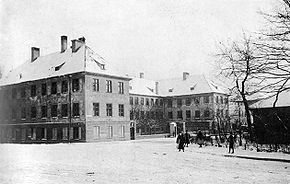Silk house barracks
The Seidenhauskaserne was an artillery - barracks of the Bavarian army in Munich . The name comes from the barracks building; Before its military use from 1803, it served briefly as a manufacture for the manufacture of silk . The barracks were located at the southeast corner of the Hofgarten , roughly where Hofgartenstrasse now passes the Bavarian State Chancellery .
Building and location
The two-story Seidenhaus barracks was on the southeast corner of the courtyard garden. Its main wing formed a right angle with the neighboring Hofgarten barracks . The parade ground between the Hofgarten and the Hofgarten barracks was thus closed to the south. To the south, on the side facing away from the Hofgarten barracks, two side wings were attached to the main wing of the Seidenhaus barracks, creating a rectangular courtyard that was open on one side.
Usage history
The building of the Seidenhauskaserne was built in 1796 as a manufacture for silk; however, it was only produced there for a short time. As early as 1803, the owner Sebastian Altmutter rented the building to the Munich garrison , which used it as an artillery barracks. Due to its room layout, the former manufacturing building was not particularly suitable for a barracks. Initially, the barracks was set up for around 250 soldiers, with the ground floor being partially privately let. In 1808 the garrison bought the house from its indebted owner. A plan to expand the building for a capacity of 500 men failed for financial reasons. In 1833 the barracks were occupied by around 340 men from the 1st Artillery Regiment. Like the Hofgarten barracks, the Seidenhaus barracks has been considered hazardous to health and unsuitable for housing soldiers since the 1850s due to its low location. After the construction of the Maximilian barracks, the artillerymen were finally relocated there, and in 1869 the district military court moved into the rooms of the Seidenhaus barracks . However, as there was not enough space for troops, soldiers moved in again, this time from the Royal Bavarian Infantry Body Regiment , which also occupied the Hofgarten barracks. Both barracks were connected by an extension in 1871. An officers' dining room was set up in 1872, and the Seidenhaus barracks were connected to the water supply from the Mangfall Valley in 1872 . The typhoid fever - epidemic in 1893 was the occasion to discontinue the Seidenhauskaserne; However, it was used for offices of the military administration for six more years and was not demolished until 1899.
literature
Christian Lankes: Munich as a garrison in the 19th century , Mittler, Berlin 1993, ISBN 3-8132-0401-4 , pp. 103-105
See also
Web links
Coordinates: 48 ° 8 ′ 30 ″ N , 11 ° 34 ′ 55 ″ E
